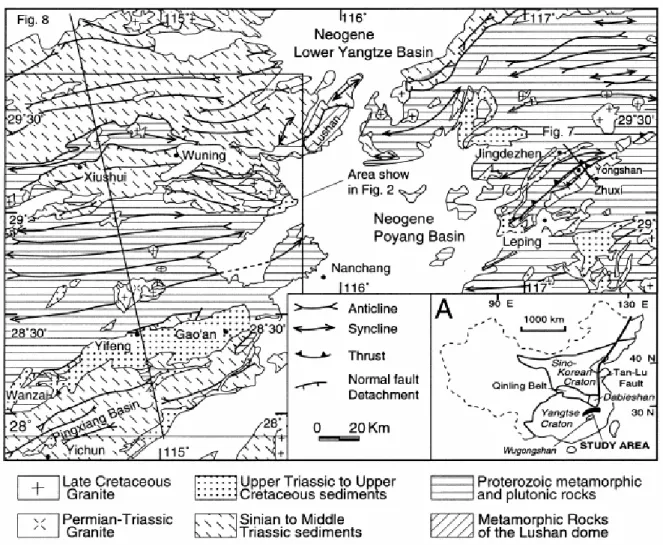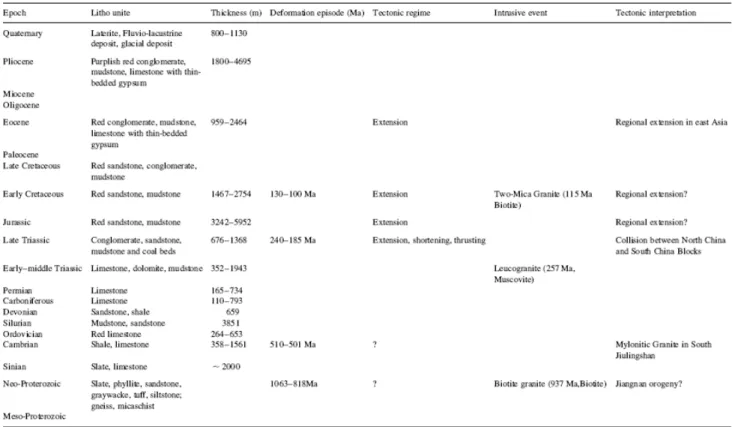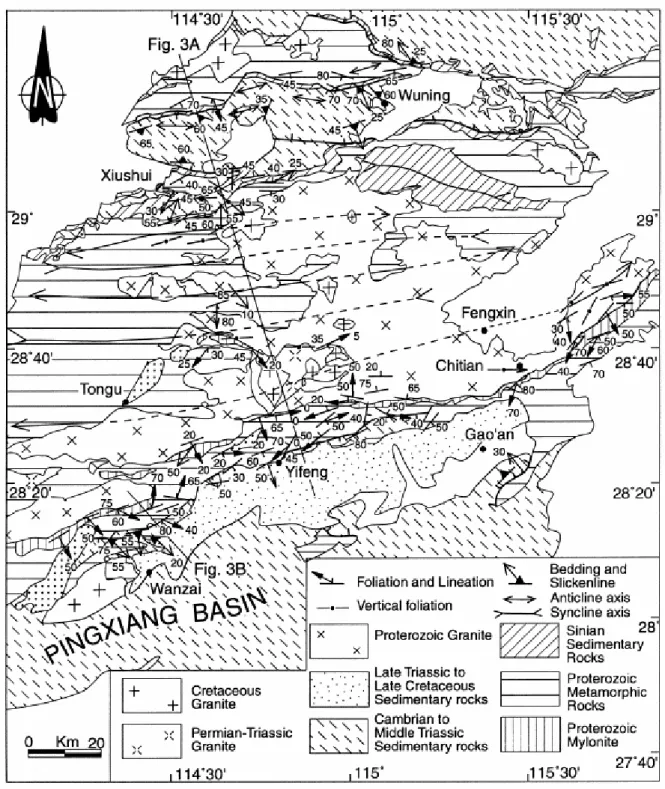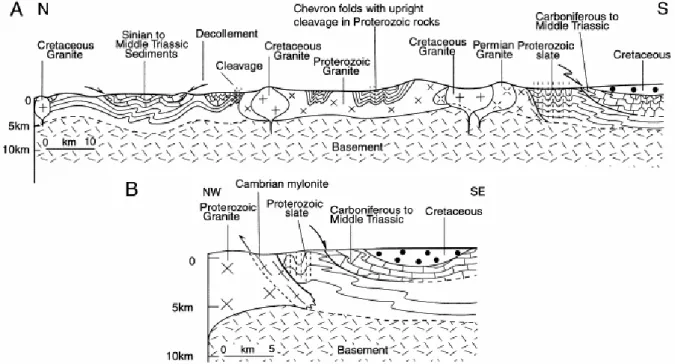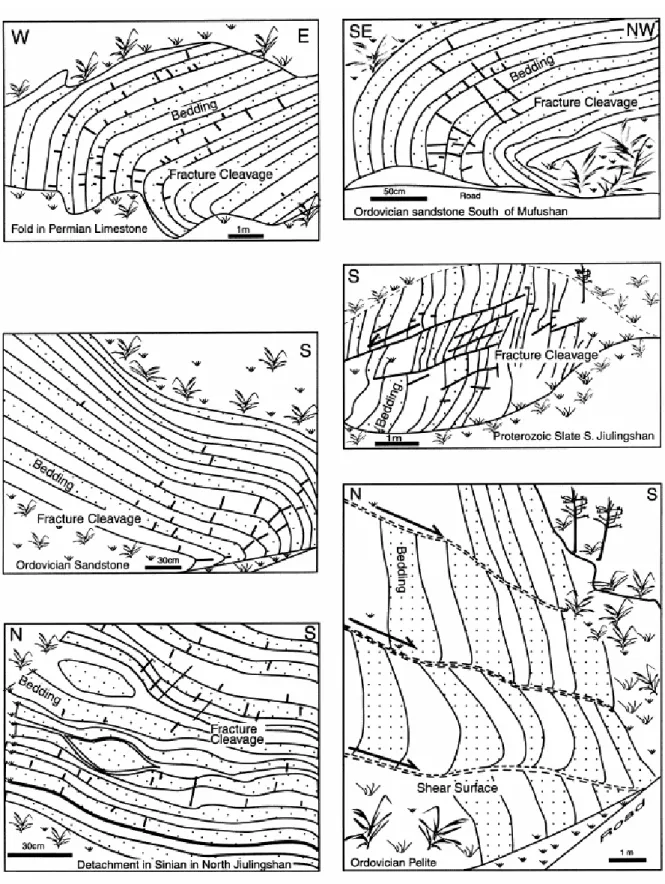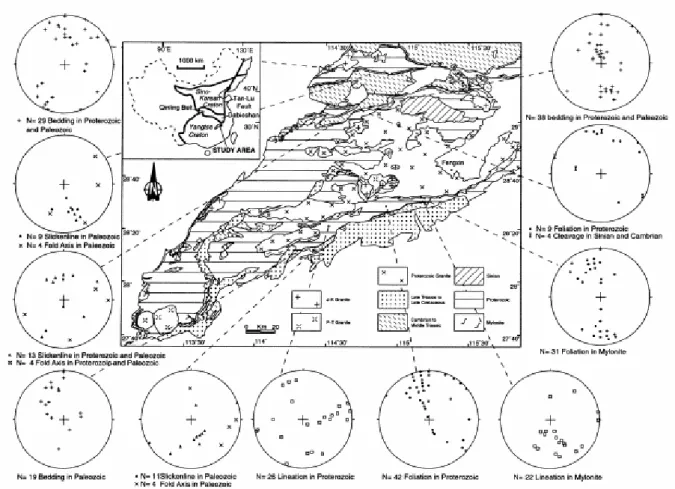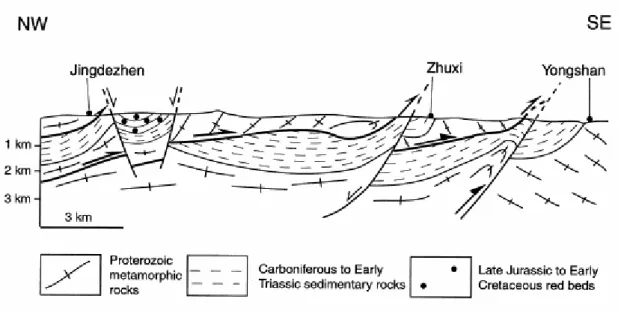HAL Id: hal-00089798
https://hal-insu.archives-ouvertes.fr/hal-00089798
Submitted on 8 Sep 2006
HAL is a multi-disciplinary open access archive for the deposit and dissemination of sci-entific research documents, whether they are pub-lished or not. The documents may come from teaching and research institutions in France or abroad, or from public or private research centers.
L’archive ouverte pluridisciplinaire HAL, est destinée au dépôt et à la diffusion de documents scientifiques de niveau recherche, publiés ou non, émanant des établissements d’enseignement et de recherche français ou étrangers, des laboratoires publics ou privés.
Compression to extension switch during the Middle
Triassic orogeny of Eastern China: the case study of the
Jiulingshan massif in the southern foreland of the
Dabieshan
Wei Lin, Michel Faure, Yan Sun, Liangshu S. Shu, Qingchen Wang
To cite this version:
Wei Lin, Michel Faure, Yan Sun, Liangshu S. Shu, Qingchen Wang. Compression to extension switch during the Middle Triassic orogeny of Eastern China: the case study of the Jiulingshan massif in the southern foreland of the Dabieshan. Journal of Southeast Asian earth sciences, Elsevier, 2001, 20, pp.31-43. �10.1016/S1367-9120(01)00020-7�. �hal-00089798�
Compression to extension switch during the Middle
Triassic orogeny of Eastern China: the case study of the
Jiulingshan massif in the southern foreland of the
Dabieshan
Wei Lina, b, Michel Faureb, Yan Sunc, Liangshu Shuc and Qingchen Wanga a
Institute of Geology and Geophysics, Chinese Academy of Sciences, P.O. Box 9525, Beijing 100029, People's Republic of China
b
Département des Sciences de la Terre, Université d'Orléans, 45067 Orléans Cedex 2, France c
Department of Earth Sciences, Nanjing University, Nanjing, People's Republic of China
Abstract
The Jiulingshan massif is an E–W trending anticlinorium in the South China Block (SCB) that forms the southern foreland of the Qinling–Dabie orogen. The Jiulingshan consists of Middle Proterozoic (ca. 1 Ga–800 Ma) metamorphic and plutonic rocks unconformably overlain by Sinian to Triassic rocks. In these cover rocks, two episodes of deformation of pre-Late Triassic age are recognized. Namely, a N–S compressional phase characterized by south verging thrusts, upright folds and vertical cleavage followed by an extensional phase characterized by layer parallel slip, collapse folds and extensional allochthons of Proterozoic slate on top of Carboniferous to Middle Triassic carbonates. The extensional tectonics appears to be a mechanical consequence of the compressional tectonics. On a regional scale, the Jiulingshan massif forms one of the domed crustal scale shear zones of the SCB that accommodated the continuing convergence that immediately followed the Qinling–Dabie collision.
Author Keywords: Jiulingshan massif; Middle Triassic orogeny; SE China
1. Introduction
The structure of SE China results from the welding of the Sino-Korean and Yangtse cratons that are also referred to as the North and South China blocks. The collision zone is occupied by the Qinling–Dabie orogen. The timing of the collision has been estimated to have various ages ranging from early Paleozoic to Jurassic (e.g. Mattauer; Mattauer et al., 1991; Hacker; Gilder and Faure and references therein). Whatever the age of the collision between the North and South China blocks, an important tectonic-metamorphic and plutonic event occurred in Permian–Triassic times. In the South China block, Triassic tectonic and metamorphic processes that produced ultra-high-pressure metamorphism are recognized in the Dabieshan ( Mattauer et al., 1991; Hacker and Liou) and also to the south in the Wugongshan ( Faure et al., 1996; Fig. 1A). The Jiulingshan massif, which lies between the two areas, is an anticlinorium of Proterozoic basement rimmed by sedimentary rocks ranging from Late Proterozoic (Sinian, around 800–600 Ma) to Late Cretaceous in age. This paper presents structural evidence for Triassic compression of the Jiulingshan followed by gravitational collapse in the Jiulingshan massif. The significance of these structures to the tectonic framework of SE China is discussed.
Fig. 1. General structural map of the Jiulingshan massif in North Jiangxi Province. A. Location map of the study area in China, with respect to Wugongshan and Dabieshan.
2. Geological overview of the Jiulingshan massif
The Jiulingshan massif (Fig. 1) is an E–W trending, topographically high area within the North Jiangxi Province. It extents from Hunan in the west to Zhejiang in the East. To the north, the massif is separated from the Dabieshan massif by the Lower Yangtse River plain in which folded and thrusted Paleozoic rocks outcrop. To the south, the Paleozoic–Mesozoic Pingxiang sedimentary basin separates the Jiulingshan and Wugongshan massifs. The Jiulingshan massif is also divided by the Neogene Poyang Lake basin into western and eastern areas. In the following we deal with the western area. In addition to plutonic rocks, the Jiulingshan massif consists of rocks that can be subdivided into two groups.
The younger and structurally higher unit consists of sedimentary rocks ranging from Sinian to Middle Triassic in age. The stratigraphic succession of these fossiliferous shales, sandstones and limestones is well established in Table 1. In contrast to other parts of SE China, such as Wugongshan, there is no Late Devonian unconformity (JBGMR, 1984). In the Northern Jiangxi Province, the sedimentary sequence is continuous from Late Proterozoic (Sinian) to Middle Triassic. However, layer parallel decollements may locally modify the normal succession. As commonly observed in the Jiangxi Province, Late Triassic terrigeneous rocks
unconformably overlie older rocks of Carboniferous, Permian, early and middle Triassic. Jurassic and Early Cretaceous sedimentary rocks are very rare. Lastly, subhorizontal or gently tilted Late Cretaceous continental red beds post-date all the regionally deformed rocks.
Table 1. Stratigraphic column of Jiulingshan
Beneath the Sinian–Paleozoic sequences are Proterozoic metamorphic rocks consisting of mostly slates and biotite phyllites with lesser amounts of micaschists and gneiss. Due to the lack of comprehensive mapping, these rocks are not distinguished on the structural map except in the Lushan dome in which complex polyphase tectonic evolution is discussed elsewhere (Fig. 1; Lin et al., 2000).
Several plutons are recognized in the Jiulingshan massif. Proterozoic biotite granite forms the central part of the massif and frequently exhibits a sub-solidus foliation. This structure is particularly easily observed along the southern margin of the plutons ranging from west of Wanzhai to East of Chitian (Fig. 2) where mylonite is developed. 40Ar/39Ar biotite and muscovite ages from this mylonitic granite are 500–550 Ma (Xu and Shu). Permian to Triassic granites dated around 260–240 Ma (JBGMR, 1984) are rare and the radiometric ages are poorly constrained. Lastly, Early Cretaceous plutons form isolated masses of relatively minor extent compared with other parts in SE China. As shown by the Sinian unconformity, most of the metamorphism and ductile deformation observed in the Jiulingshan massif belong to a Proterozoic event called the Jiangnan orogeny. A detailed study of the pre-Sinian history of the Jiulingshan massif is beyond the scope of this paper. Further information can be found in Guo; Li; Chen; Shu, 1991; Xu; Shu; Li and Charvet. In the following, we examine the deformation in the Sinian and younger rocks that form the northern and southern margins of the Jiulingshan massif. Some structures in the rocks that may be related to the younger event are also discussed.
Fig. 2. Structural map of the western part of the Jiulingshan massif (west of Nanchang).
3. Structural analysis of the Jiulingshan massif
From north of Wuning to the Pingxiang basin (Fig. 2), the Jiulingshan massif is a hundred-kilometre scale anticlinorium surrounded by Paleozoic sedimentary rocks forming the synclinorium ( Fig. 3A). Two types of deformation are recognized throughout the massif. The younger event, located at the margins of the Jiulingshan massif, is an extensional event that overprints a shortening event. For each of these two tectonic events, the deformation exhibits a similar structural style regardless of formation age from Sinian to Middle Triassic. In the
following, the younger extensional structures are described first. Since there is no unconformity within these strata, all the extensional structures observed are considered coeval.
Fig. 3. A. Cross-section of the western part of the Jiulingshan massif. B. Detail cross-section of the southern margin of the Jiulingshan near Wanzai (location in Fig. 2).
3.1. Structures due to extensional tectonics
Brittle normal faults and down-dip slickenlines are widespread in the Carboniferous and Permian limestones. Intensely sheared decametre-scale cataclasites and breccias zones are also observed. In addition to high angle normal faults, evidence for slip on the layers is provided by striated bedding planes, calcite or quartz fibers, tension gashes oblique to the slip surface and sigmoidal veins (Fig. 4D,E,I). Asymmetric boudins also indicate down-dip shearing along decollement levels (Fig. 4F,G). Lastly, in the most competent lithology, such as the coal measures in the Permian carbonates or pelitic joints in the Paleozoic sequence, drag and disharmonic folds are well developed ( Fig. 4 and Fig. 5). Drag folds are also observed in the Proterozoic slate. For instance, near Yifeng along the southern margin of the Jiulingshan, chevron folds with subhorizontal or southward dipping axial planes indicate a southward vengence.
Fig. 4. Examples of the common compressional and extensional structures found in the Jiulingshan massif. (A) South verging brittle thrust cutting Ordovician turbidite (North of Wuning). (B) Vertical cleavage in Sinian beds (East of Xiushui). (C) Upright chevron folds in Proterozoic slate refolding the Proterozoic foliation and lineation (East of Yifeng). These folds are related to the Triassic horizontal shortening. (D) Layer parallel decollement marked by calcite veins in Cambrian limestone (Xiushui city). (E) Hectometre-scale decollement with normal
displacement along coal layers in Permian limestone formation (near Gao'an). (F) South dipping brittle shearing in massive Permian limestone, near Wanzai, West of Yifeng. The sigmoidal shape of the lenses indicates a top-to-the-South Shearing. Scale bar is 1 m. (G) Detail of slip on a coal measure in the Permian series, east of Yifeng. Scale bar is 10 cm. (H) Detail of a decollement layer in the coal series showing drag folds and sigmoidal structures, (east of Yifeng). (I) Calcite veins in Cambrian limestone North of Wuning showing slip on the layers and a normal sense of motion.
Fig. 5. Examples of folded and sheared Proterozoic and Paleozoic rocks on both limbs of the Jiulingshan anticline (redrawn from pictures).
3.2. Kinematic pattern related to extensional tectonics
In the whole study area, the slickenlines related to extensional tectonics trend dominantly NS (Fig. 6) and the sense of motion is always downward. Top-to-the-south and top-to-the-north shearing is observed on the southern and northern limbs of the upright folds, respectively. Near Yifeng, Proterozoic slate overlies Permian–Carboniferous limestone along10 m thick foliated cataclasite. This tectonic superposition has been interpreted either as indicating the occurrence of a north (Hsu et al., 1990) or south verging nappe ( Zhu; Zhu; Zhong; Zhu and Fan). Alternatively, an interpretation in terms of extensional tectonics which better accounts for the geometry of this structure has been put forward ( Faure et al., 1998). Indeed, the extent of this abnormal superposition of Proterozoic rocks above Paleozoic–Mesozoic ones is always limited to a few hundred meters, so that it cannot be represented on the general structural map ( Fig. 2). Along the southern margin of the Jiulingshan, the Proterozoic slate forms extensional allochthons developed during the regional shortening. A genetic model accounting for these structures considers that the horizontal layers were rotated during the regional folding leading to the formation of the Jiulingshan antiform. When sliding was allowed due to the internal friction of rocks, collapse-style folds formed and their inverted limbs were sheared. Consequently, the old inner beds of the normal limbs tectonically overlie young outer beds.
E–W trending folds with subhorizontal axial planes, which dip to either side, are common on both limbs of the Jiulingshan anticline. This kind of fold indicates that vertical shortening acted upon an already tilted layer. Similar structures have been also described on both flanks of the Wugongshan dome and on the south flank of the Dabieshan (Faure and Faure). The age of folding and shearing is stratigraphically constrained by Late Triassic or Jurassic unconformities in the Wugongshan and Dabieshan massifs, respectively. In the central Jiulingshan massif that belongs to the east part of Hunan province, Late Triassic rocks are unconformable deposits on the Proterozoic metamorphic rocks ( Fig. 6) ( HBGMR, 1988). Therefore, an accurate timing of deformation was demonstrated as pre-Late Triassic in age.
East of Chitian, the southward dipping Proterozoic foliation in biotite granite is reworked by high angle shear bands along which biotite is retrogressed to chlorite. Top-to-the-south motion indicated by these shear bands is in agreement with a normal sense of displacement. Post-foliation shear bands in granite and folds in slate post-date the ductile deformation related to the Proterozoic tectonics. Although radiometric dating of this deformation is impossible, the consistency of their strain axes with those inferred from the Sinian to Middle Triassic series suggests a synchronous development during a deformation characterized by vertical shortening.
Fig. 6. Stereograms of the structural elements in the Jiulingshan massif.
3.3. Structures related to shortening
Several features argue for Triassic horizontal shortening. The strongest evidence is provided by a sequence of south-directed thrusts developed between Jingdezhen and Leping (JBGMR, 1984 and Zhong; Fig. 7). There, the foliation of the Proterozoic slate and phyllite is cut by large flat-lying thrusts emplaced onto Triassic sandstone or Permian limestone. Although the thrust surface itself was not observed in the field, the abnormal superposition of older rocks upon younger ones has been verified by drilling and coal mining (JBGMR, 1984).
Shortened structures are also recognized in the western part of the Jiulingshan massif. Between Xiushui and Wuning (Fig. 1), low-angle, south-directed brittle thrust faults, appearing as a normal fault in Fig. 1 and Fig. 2, are observed in the Cambrian and Ordovician sandstone ( Fig. 4A). Farther west, east of Xiushui, Sinian greywacke and conglomerate unconformably cover the Proterozoic slate but a vertical cleavage developed in the Sinian greywacke and shale indicate the existence of an important horizontal shortening ( Fig. 4B). N–S shortening structures are also observed in the Proterozoic slate. For instance, in the central part of the Jiulingshan, the Proterozoic foliation and lineation are folded by upright chevron folds ( Fig. 4C). NE of Yifeng, on the southern limb of the Jiulingshan antiform, brittle-ductile reverse faults with top-to-the south sigmoidal lenses cut across the Proterozoic foliation. All these observations indicate that the Late Proterozoic–Early Mesozoic sedimentary cover of the Jiulingshan massif experienced bulk N–S shortening and southward thrusting before the extension. Due to the lack of Late Paleozoic–Early Mesozoic rocks in the central part of the Jiulingshan antiform, this kind of contractional structure has not been
unambiguously dated. It can only be bracketed between the Middle Paleozoic and Cretaceous. However, on the basis of the regional geology of the Jiangxi Province ( JBGMR, 1984), all these shortened structures are related to Triassic deformation.
Fig. 7. Cross-section of the eastern Jiulingshan massif located in Fig. 1, showing southward vergent thrusts of Proterozoic slate upon Carboniferous to early Triassic sedimentary rocks (simplified from Zhong, 1992).
4. Discussion: compression to extension switch during the
Triassic Indosinian orogeny
The above-presented data allow us to propose and interpret the shortening and stretching deformations of the Jiulingshan Massif. The shortened structures cannot be separated from those observed in the nearby Lushan Massif (Fig. 1). There, a deep-seated thrusting coeval with kyanite crystallization developed in the Proterozoic and Sinian rocks ( Lin et al., 2000). The time of thrusting is assumed to be Late Triassic since the entire sequence from Sinian to middle Triassic is involved in the deformation and the Late Triassic unconformably overlies the pre-late Triassic strata. In Lushan, the main deformation that follows the compression corresponds to an extensional decollement along the Sinian–Middle Proterozoic boundary. The Lushan Massif exposes the deep part of the same thrust system described here near Leping ( Fig. 7) and in Western Jiulingshan. These structural data are used to draw an interpretative crustal scale cross-section showing the development of a blind thrust reworked by Triassic normal faults ( Fig. 8).
Fig. 8. Crustal scale cross-section of the whole Jiulingshan massif showing a deep seated blind thrust cut by Triassic normal faults. The number of granitic plutons has been minimized.
Indeed, compressional and extensional tectonics are not independent, but the succession can be explained by a progressive change of maximum shortening direction from subhorizontal in the early stages to vertical. First, the Proterozoic basement and its Sinian to Middle Triassic cover are deformed by top-to-the-South thrusting (Fig. 9A). While the convergence is occurring, subhorizontal shearing is unable to account for the deformation of the South China Block. Thrusting is followed by a nearly coaxial regime. The maximum shortening (X axis of the strain ellipsoid) rotates from an oblique position during the shearing towards a horizontal orientation during the coaxial regime. This last position gives rise to upward folding and vertical cleavage (Fig. 9B). Lastly, the large-scale fold of the Jiulingshan antiform induces a gravitational instability that is removed by normal faulting, collapse folds and slip on the tilted layers ( Fig. 9C). As already suggested, this deformation belongs to the tectonic event recognized in the South China Block in the foreland of the Qinling–Dabie belt ( Faure et al., 1998).
Fig. 9. Schematic model showing how extensional structures can develop as a consequence of regional shearing and thrusting. When horizontal shearing is blocked, deformation continues as coaxial horizontal shortening. Lastly, gravitational collapse accommodates the releasing of vertical thickening.
In a broader sense, the compressional tectonics of the Jiulingshan is related to those of the Dabieshan (Okay and Hacker). During Permian–Triassic times, the North China Block and South China Block convergence was accommodated by northward subduction of the South China Block and simultaneously by southward thrusting within the continental crust of the South China Block. The deformation is not restricted to the Qinling–Dabie belt, but the whole South China Block experienced large-scale deformations linked with the collision. The Proterozoic basement with its Sinian–Paleozoic cover is sliced into several thrust sheets such as presented above in the Jiulingshan or formerly described in the Wugongshan ( Faure and Faure). The location of these shear surfaces might be controlled by inherited Proterozoic structure of the South China Block In fact, rift-related Middle Proterozoic magmatism and Late Proterozoic ophiolitic nappes recognized in the Jiulingshan area (e.g. Guo; Shu, 1991 and Xu) may have exerted a significant influence in the localization of thrust zones. At depth, as it can be observed in the Lushan massif ( Lin et al., 1999), the shearing is coeval to metamorphism and at shallower levels; ductile to brittle deformation accommodates the thrusting.
On the scale of the southern foreland of the Qinling–Dabie belt, domal structures such as Jiulingshan, Wugongshan or Lushan are characterized by conspicuous extensional features that appear to be the result of continental convergence between the North China Block and South China Block. Thus according to this model, the extensional tectonics immediately preceded the compressional phase.
Acknowledgements
This work that is a part of W. Lin PhD has been supported by Major State Basic Research Development Program of China [G1999075510], the National Science Foundation of China, foundation of Chinese Academy of Science for the outstanding abroad Chinese student and by a scholarship of the French Ministry of Foreign Affairs. The Jiangxi Bureau of Geology and Mineral resources provided assistance in the field. The journal editor in Chief Kevin Burke is thanked for his constructive comments.
References
Charvet, J., Cluzel, D., Faure, M., Caridroit, M., Shu, L. and Lu, H., 1999. Some tectonic aspects of the pre-Jurassic accretionary evolution of East Asia. In: Metcalfe, I., Editor, , 1999.
Gondwana Dispersion and Asian Accretion IGCP Final Results Volume, Balkema,
Amsterdam, pp. 37–65.
Chen, J., Foland, K.A., Xing, F., Xu, X. and Zhou, T., 1991. Magmatism along the southeast margin of the Yangtse block: Precambrian collision of the Yangtse and Cathaysia blocks of China. Geology 19, pp. 815–818.
Fan, G., 1993. Criteria for the determination of the location of the frontal zone and vergence of migration of the Nanchang–Yifeng thrust nappe structure. Regional Geology of China 3, pp. 229–254.
Faure, M., Sun, Y., Shu, L., Monié, P. and Charvet, J., 1996. Extensional tectonics within a subduction-type orogen. The case study of the Wugongshan dome (Jiangxi Province, SE China). Tectonophysics 263, pp. 77–108.
Faure, M., Lin, W. and Sun, Y., 1998. Doming in the southern foreland of the Dabieshan (Yangtse block, China). Terra Nova 10, pp. 307–311.
Faure, M., Lin, W., Shu, L., Sun, Y. and Schärer, U., 1999. Tectonics of the Dabieshan and its bearing on the exhumation of the ultra high-pressure rocks. Terra Nova 11, pp. 251–258.
Gilder, S.A. and Courtillot, V., 1997. Timing of the North–South China collision from new middle to late Mesozoic paleomagnetic data from the North China Block. Journal of
Geophysical Research 102, pp. 17,713–17,727.
Guo, L., Shi, Y. and Ma, R., 1980. The geotectonic framework and crustal evolution of South China. In: Scientific Paper for International Exchange 1, Geological Publishing House, Beijing, pp. 109–116.
Hacker, B.R., Wang, X., Eide, E.A. and Ratsbacher, L., 1996. The Qinling–Dabie ultrahigh-pressure collisional orogen. In: An Yin and Harrison, T.M., Editors, 1996. Tectonic Evolution
of Asia, Cambridge University Press, Cambridge, pp. 345–370.
HBGMR, Hunan Bureau of Geology and Mineral Resources, 1988. Regional Geology of Hunan Province, Geological Publishing House, Beijing, 719 pp.
Hsu, K.J., Li, J., Chen, H., Wang, Q., Sun, S. and Sengor, A.M.C., 1990. Tectonics of South China: key to understanding West Pacific geology. Tectonophysics 183, pp. 9–39.
JBGMR, Jiangxi Bureau of Geology and Mineral Resources, 1984. Regional Geology of Jiangxi Province. Geological Publishing House, Beijing, 921 pp.
Li, D., 1987. The study on mylonite in the root zone of nappe in the southern edge of Jiulingshan Jiangxi. Earth Science 12, pp. 511–517 (in Chinese).
Li, X., Zhao, J., McCulloch, M.T., Zhou, G. and Xing, F., 1997. Geochemical and Sm–Nd isotopic study of Neoproterozoic ophiolites from southeastern China: petrogenesis and tectonic implications. Precambrian Research 81, pp. 129–144.
Lin, W., Faure, M., Monié, P., Sun, Y., Schaerer, U. and Zhang, L., 1999. Tectonics of the South China Block. New insights from the Lushan massif. EUG 10. Journal of Conference 4, p. 37.
Lin, W., Faure, M., Monié, P., Sun, Y., Schaerer, U. and Zhang, L., 2000. Tectonics of the South China Block. New insights from the Lushan massif (Jiangxi Province). Tectonics 19, pp. 852–871.
Liou, J.G., Zhang, R.Y., Wang, X., Eide, E.A., Ernst, W.G. and Maruyama, S., 1996. Metamorphism and tectonics of high-pressure and ultrahigh-pressure belts in the Dabie–Sulu region, China. In: Yin, A. and Harrison, T.M., Editors, 1996. Tectonic Evolution of Asia, Cambridge University Press, Cambridge, pp. 300–344.
Mattauer, M., Matte, P., Malavieille, J., Tapponnier, P., Maluski, H., Xu, Z., Lu, Y. and Tang, Y., 1985. Tectonics of the Qinling Belt: build-up and evolution of Eastern Asia. Nature 317, pp. 496–500.
Mattauer, M., Matte, P., Maluski, H., Xu, Z., Zhang, Q., Wang, Y., 1991. La limite Chine du Nord-Chine du Sud au Paléozoïque et au Trias: Nouvelles données structurales et radiométriques dans le massif du Dabieshan (chaîne des Qinling). Comptes rendus de l'Académie des Sciences, Paris 312, pp. 1227–1233.
Okay, A., Sengor, A.M.C. and Satir, M., 1993. Tectonics of an ultrahigh-pressure metamorphic terrane: the Dabieshan/Tongbaishan orogen, China. Tectonics 12, pp. 1320– 1334.
Shu, L., 1991. The Late Proterozoic Terrane tectonics and collision orogenic belt in north Jiangxi, eastern China. PhD Thesis. Nanjing University, Nanjing, 125 pp.
Shu, L., Zhu, G., Shi, Y. and Yin, J., 1994. Study of the HP metamorphic rocks and its Late Proterozoic age in the Eastern Jiangnan belt. Chinese Science Bulletin 39, pp. 1200–1204.
Xu, B., Guo, L. and Shi, Y., 1992. Proterozoic Terranes and Multiphase Collision Orogens in
Anhui–Zhejiang–Jiangxi areas, Geological Publishing House, Beijing (112 pp.).
Zhong, N., 1992. Nappe structure in the Pingxian–Leping area, Jiangxi. Regional Geology of
China 1, pp. 1–13.
Zhu, Z. and Fan, G., 1992. On Nanchang–Yifeng thrust nappe system of Pingle depression zone and its relationship with the gliding nappe-thrust nappe system on the north side of Wugongshan. In: Ma, X., Yang, S. and Zhu, Z., Editors, 1992. Continental Tectonics in
China, China University of Geosciences Press, Wuhan, pp. 51–62.
Zhu, Z., Ye, J. and Yang, K., 1987. On thrust-nappe and gliding-detachment on both sides of Mufushan–Jiulingshan uplift and asymmetrical tectonic architecture of mountains. Earth
Sciences 12, pp. 503–510 (in Chinese).
Zhu, Z., Ma, C. and Yang, K., 1989. Multilevel gliding detachment in southeast Hubei and its convergence–connexion relationship with multilevel gliding detachment of Tongbai–Dabie mountain. Earth Science 14, pp. 19–27 (in Chinese).
